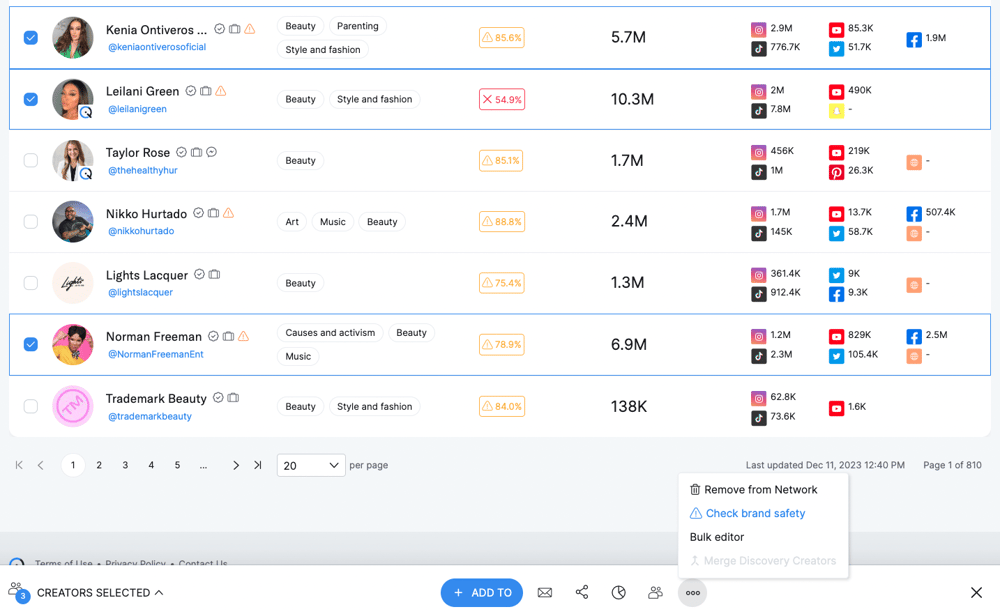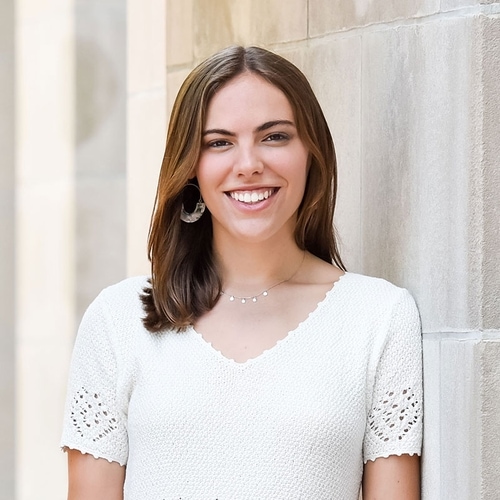The concept of brand safety has gone hand in hand with media advertising for decades. Advertisers have long been mindful of the content that’s followed their brand ad, and take care to consider the associations consumers might make, from television ads to digital ads to social media. When the content and the advertisement become integrated—as it does within influencer marketing—the need for brand alignment is even more crucial.
With recent advancements in AI and machine learning technology, brand safety in the influencer marketing industry is evolving. At the same time, as brands invest in longer term creator partnerships, brand safety and alignment has become a renewed priority. But the brand safety of today and tomorrow doesn’t look like it did even a few years ago.
We were fortunate enough to sit down with two experts from CreatorIQ—Customer Success Manager Arika Vissers, and Senior Technical Manager Jonathan Iyandemye—to discuss the past, present, and future of brand safety: why it’s so important to our clients, and how it will impact creator marketing.
Read on for the full Q&A with Arika and Jonathan, and watch this 3-minute clip for a quick rundown on how we’re thinking about and solving for key challenges around brand safety:
Q&A with Arika Vissers and Jonathan Iyandemye:
Q: Arika, as a Customer Success Manager, you speak with a wide array of brands and agencies. How would you describe what brand safety means to the organizations you work with?
Arika: Over the last couple of years, we've heard from a lot of brands and agencies that they’re focused on building out true partnerships with the creators they're working with. So with that, there's a lot of time and investment that goes into building out those partnerships, and there's more vetting that brands and agencies need to do to make sure those creators are the right partners for them. At the end of the day, brands and agencies have core values, and the brand safety portion of this vetting helps to avoid any crisis or surprises in those long-term partnerships.
Q: From your observation, what key challenges do brands face in safeguarding their brand identities while engaging in creator marketing?
Arika: A lot of times when I'm talking to brands and agencies about brand safety, they don't necessarily know where to start. Do you pick a category? How do you know what words to flag? How do you know what aligns directly with your core values?
But I think, too, it does take a lot of time. I'll let Jonathan dive into our new functionality that we have within the platform, but previously it took a lot of time to sort through each partner that you're looking to work with: all their posts, everything that they've mentioned. Going through all of that is a very time-consuming process.
Q: Jonathan, you’ve been hands-on in building our new brand safety and legal drinking age compliance capabilities. Could you describe how you approached the problems that brands face?
Jonathan: That’s a great question. Our approach to solutions for some of the problems that our clients have faced as far as brand safety is twofold. We thought about it from a first line of defense approach, as well as a brand alignment approach. Let me explain what these approaches mean.
As Arika mentioned, clients are looking to build long-term relationships with creators. Like any relationship, they have to start on a solid foundation of trust. So the first line of defense approach is about ensuring compliance and safety right from the outset.
For us, that means discovery. Discovery is where you start looking for creators who you eventually want to work with. For instance, today we have tools in Discovery that allow you to quickly identify brand-safe creators, analyzing as much as three years of historical content for any flags. And we have tools that allow you to identify creators whose audience demographics align with the legal drinking age (LDA) requirements that you may have, depending on where you operate. By bringing these brand safety and LDA tools to Discovery, we are empowering brands to significantly reduce the risk of non-compliance and potential brand reputation issues down the road.
The second approach is brand alignment. Traditionally, brand safety involved staying away from being associated with universally negative content, like hate speech or explicit material. But we know that brand safety has evolved over time. In 2023, brand safety means brand alignment. So when we build features for brand safety, we have to introduce a high level of flexibility and customization for clients. If a financial brand, for instance, wants to stay away from crypto-friendly influencers, that is something they should be able to do with our tools. Yet, 10 years ago, many of us didn't even know what crypto was. We have to build with that in mind, with the potential to adapt the features to meet the needs of clients today, right here, right now.

Q: From your perspective, Arika, how would you say brand safety concerns are different today than they may have been in years past?
Arika: I think Jonathan did a really nice job outlining those differences, but I’d add that what we're seeing now with brand safety is that it’s become almost a requirement when validating partnerships. Every brand and agency most likely knows what their core values are. And I think that's a good way to think about this. Does a partner align with the values of the brand or company that they're going to be working with? At the end of the day, we all understand that creators have influence, and they have a lot of eyes on them because of that influence. So because of that, you want to make sure that the partnership you're building aligns with those core values. So I don't think that brand safety didn't matter in the past. It's just truly a heightened focus and something that’s more required during the vetting process. People are taking it to new levels.
Q: Jonathan, how do you think software like CreatorIQ will change how organizations curate and protect their brand image?
Jonathan: That's a great question. My hope is that CreatorIQ will automate all the groundwork that clients and brands have to do in vetting creators and ensuring brand alignment. The software has progressed quite a bit in just the last year, with AI and large language models. That progress has meant that a lot of the tasks that Arika mentioned, the time-consuming tasks like post review, can be done seamlessly today. We're working towards a future where clients can easily shortlist creators that are holistically brand-aligned and compliant based on the specific requirements of the brand. We’re planning to get to a place where the bulk of the time that brands spend is on nurturing and activating creators, rather than reviewing posts and confirming whether the creator is brand-aligned.
In 2023, brand safety means brand alignment.
Jonathan Iyandemye, Senior Technical Manager, CreatorIQ
Arika: And I'm going to jump in and add something here as well, because one thing that I talk to a lot of brands and agencies about is that we're not necessarily trying to remove the human aspect of this. There's always going to be some form of validation that needs to be done by a human at the end of the day. Really what we're trying to do is make it, as Jonathan was saying, as seamless as possible, and bring everything to light so you can do those validation checks quickly, versus having to sit there and scroll through hundreds and thousands of posts to make sure that a creator is aligned with your brand.
Q: The new brand safety capability is available to CreatorIQ users today. How have you seen users actually applying it in their programs? Have you been surprised by any of the applications you’ve seen?
Jonathan: We've seen a lot of interest in this feature. One notable observation is that some clients are using our brand safety tools to signify the level of risk that a creator carries based on the content that they create. So instead of creating categories of content to flag, like politics and race, they are essentially assigning a risk factor to the content using tools like words, such as high risk, medium risk, and lower risk. Then they assign colors, like green, yellow, and red, as guidance toward what level of vetting needs to happen for each creator they're looking at. That's one of the most interesting applications we've seen.
Q: It sounds like there’s potential for some advanced applications of brand safety. Arika, what recommendations would you give to a brand that’s just getting started in defining its brand safety guidelines?
Arika: Yeah, so I have 2.5 recommendations—you'll see why the last one's a point five.
The first one I’ll call out is don't be afraid to just get started. Maybe you put in a few words that are based on a category. Play around with it and see what works, and maybe what doesn't work. Another interesting idea is putting in some of your competitors and seeing if anyone's mentioning them in a certain time period.
The second recommendation is to really think about the core values of the brand or agency, and translate those core values to brand safety flags or triggers that we would want to look at within the CreatorIQ platform.
The last one, the point five, is that if you have in-house legal counsel, they can probably help create brand safety guidelines for you.
Jonathan: I’ll add that we are here to partner with our clients, so we are all ears and ready to get your feedback and take that into account to simplify the process of vetting creators.
Arika: That’s a great call out. If you’re working with your Customer Success Manager, ask them! A lot of times they’ll have tips and tricks and recommendations to get started.
Q: To close us out—Jonathan, how do you hope to evolve CreatorIQ’s solutions to better help organizations achieve their brand safety goals?
Jonathan: I think the key lies in a deeper understanding of creators and brands and their needs, and then using that deeper understanding of both parties to streamline the process for vetting creators and ensuring brand alignment via automation.
By leveraging machine learning and AI, we're working towards a future where, upon opening CreatorIQ on the homepage, in lists and in your CRM, you're presented primarily with creators who are aligned closely with your brand values by default. We're presenting you front and center with creators who we believe are most brand-aligned. This integration, we hope, will extend to every aspect of the platform. It will not remove the vetting process, as Arika mentioned, but we'll simplify it, and streamline it, ensuring that clients can connect with suitable creators quickly and seamlessly.

